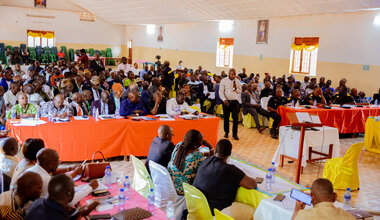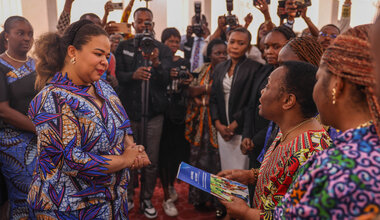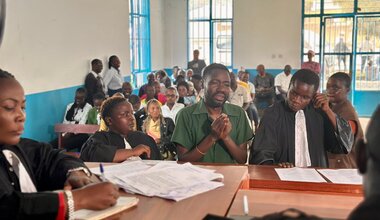Nyiragongo Volcano Eruptions: Ten Years Later
Goma, 19 January 2012 – 17 January 2012, ten years after the eruption of Nyiragongo volcano, the United Nations Office for Project Services (UNOPS), in partnership with the Goma Volcano Observatory (OGV in French), organized a conference on volcano risk management at Virunga which has a cross-border dimension. It should be recalled that a support project to OGV's monitoring and surveillance of the Virunga active volcanoes was launched in 2009 and implemented by UNOPS. The US $2,100,000 project was funded by the European Union and the Swiss cooperation.
Hundreds of participants from the Democratic Republic of Congo's Nord Kivu and Rwanda's Western province, including the Observatory Director, UNOPS project Chief, and the Head of MONUSCO provincial Office, attended the historic conference.
Discussions focused on the urgent need for upgrading communication on the DRC's volcano risks on the one hand, and on the other, the demographic growth of the city of Goma that soared from 400,000 in 2010 to 1,000,000 in 2010. Just on the outskirts of Goma, Nyiragongo volcano is extremely active with its crater having the largest lava lake in the world.
Dario Tedesco, volcanologist and Head of the supportive project outlined the sensitization strategy which consists of organizing education campaigns in schools as well as in public and private areas, using flyers, posters, t-shirts, photos and film to increase public awareness about volcano-related risks. Furthermore, the UN-sponsored Radio Okapi broadcasts weekly scientific and sensitization programs on the volcano risks. A website has also been developed to teach the population about the risks.
Mr. Tedesco insisted on the Contingency Plan that concerns directly the cities of Goma in the DRC and Gisenyi in Rwanda. A camera installed inside the Nyiragongo crater in November 2011 will soon be operational, according to him.
MONUSCO has been using its helicopters to fly volcanologists over the Virunga volcanoes. Since the eruption two months ago of the Nyamulagira, these flights have helped provide humanitarian agencies and provincial authorities with relevant information.
"This is a long-term undertaking, for the contingency plan must be updated on a regular basis," the Head of MONUSCO in Nord Kivu, Hiroute Guebre Sellassie, told her counterparts. "All stakeholders should be updated and own the contingency plan for it to be fully relevant," she said.
Nyiragongo (the 'smoker' in the local language) and Nyamulagira (the 'commander') have both a mythical meaning for the indigenous people living at the feet of the two volcanoes, the ancestral home of the dead that strive to stir up the flame of the mountain, according to local beliefs. Nyiragongo and Nyamuragira are very active and have gone through several eruptions since 1880. The last eruption was on 17 January 2002. Cracks let out substantial flow of fluid lava that runs across the city of Goma into Lake Kivu.
Clara Padovan/ MONUSCO and Dario Tedesco/ UNOPS
 ONU
ONU Nations Unies Maintien de la paix
Nations Unies Maintien de la paix





